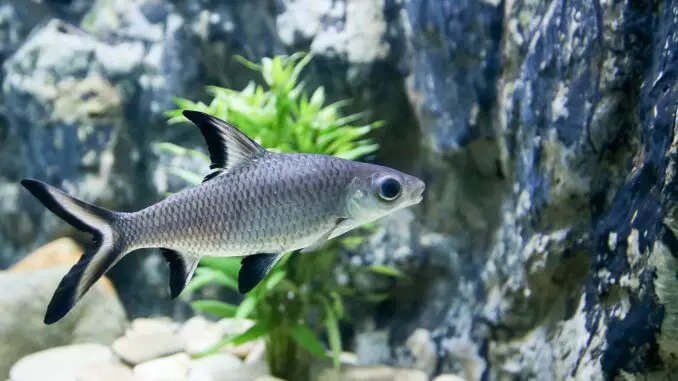
The bala shark is a freshwater species of the Cyprinidae family. Bala sharks have gray or silver bodies with long, pointed yellow or gray fins edged with black.
Bala sharks are popular with aquarists due to their shark-like body shapes and striking fin patterns. These peaceful shoaling fish are less aggressive and territorial than actual freshwater sharks.
TABLE OF CONTENTS
Bala Shark Facts & Overview
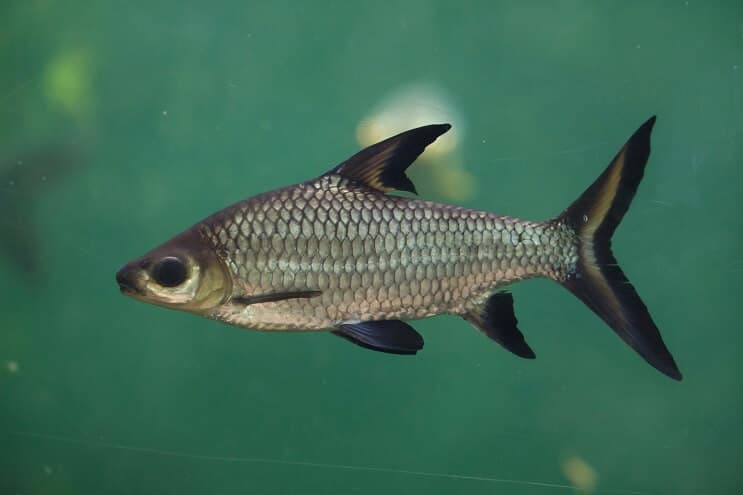
| Scientific name: | Balantiocheilos melanopterus |
| Common names | Bala shark, silver shark, tricolor shark, tricolor sharkminnow |
| Distribution: | Southeast Asia |
| Size: | Up to 14 inches |
| Life expectancy: | Up to 10 years |
| Color: | Silver with gray or yellow and black fins |
| Diet: | Omnivore |
| Temperament: | Peaceful |
| Minimum tank size: | 120 gallons |
| Temperature: | 72–82°F (22–28°C) |
| pH: | 6.0–8.0 |
| Hardness: | 5–12 dGH |
| Care level: | Easy |
| Breeding: | Egg-layer |
Origin
Bala sharks are native to the clean, freshwater rivers and lakes of Southeast Asia, including around the Malay Peninsula, in the Chao Phraya and Mekong basins, and in the waters surrounding Sumatra and Borneo.
Bala sharks are an endangered species that are rarely found in the wild. Overfishing for the aquarium trade and forest fires in 1975 are two possible causes for the decrease in the wild population of bala sharks.
The natural habitat of the bala shark is warm and densely vegetated, with a muddy, pebbly substrate. Bala sharks prefer fast-flowing waters, and swim in the midwater regions of their habitat.
Adult Size & Lifespan
Bala sharks grow up to 14 inches long. Female bala sharks stop growing before the males, so male bala sharks are longer than females. Female bala sharks have rounder bellies than males.
The average lifespan of a bala shark is between eight and ten years.
Availability
Bala sharks can be purchased online easily, but the fish are difficult to find in small, local fish stores. When buying a bala shark, make sure the fish has been bred in captivity, to protect the species’ wild populations.
The typical cost of a bala shark is $7 to $10. You can buy them from the following reputable online stores:
Appearance & Behavior
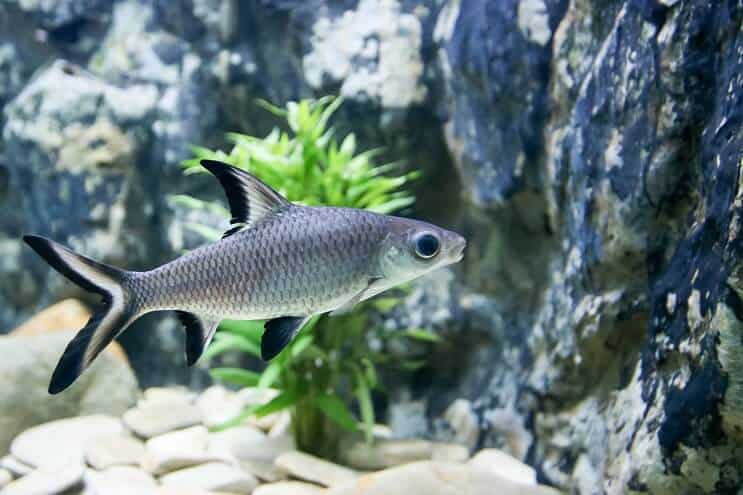
Bala sharks have long, silver bodies with bold, pointed fins. They are peaceful fish with laid-back personalities.
Colors, Patterns, Fins, and Sex Differences
The bala shark isn’t a real freshwater shark. The fish is called a bala shark because of its long, pointed dorsal fin, which resembles a shark’s fin.
Bala sharks have long, torpedo-shaped, silvery-gray bodies with silver or yellow fins edged with black. The fish’s ventral fins are small and colored black or gray. Its body is lighter gray at the top than at the bottom.
The bala shark’s small, closely-packed scales are iridescent, meaning that they reflect light as the fish moves, creating a shimmering appearance.
Typical Behavior
The bala shark is a peaceful fish that gets along well with other peaceful species in a community tank. As a shoaling fish, the bala shark feels most comfortable when housed with at least four other fish of its kind.
Bala sharks are fast, active swimmers that dart around the middle of the tank. As diurnal fish, they are more active in the day than the night.
Bala sharks are timid and easily scared, and spend a lot of time hiding in caves and behind plants.
Bala Shark Care & Tank Requirements
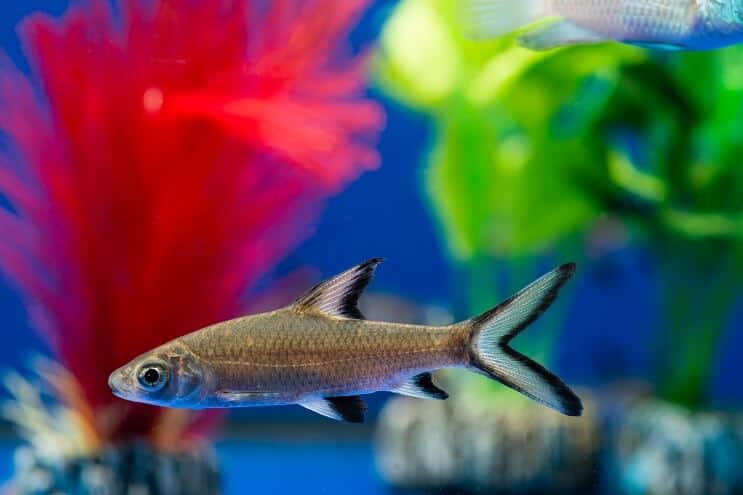
Caring for bala sharks is easy as long as you provide stable water conditions and enough space for these active swimmers to explore. House bala sharks in a freshwater tank and feed them an omnivorous diet.
Habitat and Tank Requirements
The bala shark’s natural habitat is lakes and fast-flowing rivers and streams in Southeast Asia. These fish are used to warm waters with a pebbly or muddy substrate.
Set up your bala shark’s tank to replicate the fish’s habitat in the wild. Fully-grown bala sharks should be housed in a tank of at least 150 gallons, at least 5 feet across. The longer the tank, the more space this middle-dwelling fish has to explore.
Bala sharks don’t swim along the bottom of the tank or dig in the substrate, so there’s no need to use a specific type of substrate. However, a dark-colored pebbly substrate, around ½ an inch thick, is closest to the substrate found in the fish’s wild habitat.
There’s also no need to fill bala sharks’ tanks with rocks or plants. However, a few plants, like anubias, can make them feel more at home in captivity and provide a hiding place for tired or nervous fish. Plant vegetation around the edges of the tank to prevent disruption to the swimming areas.
Bala sharks are known to jump out of the tank, especially when settling into their new environment, so a secure lid on top of the tank is essential.
Tank Conditions
The ideal tank conditions for bala sharks are:
| Water type: | Neutral, fast-flowing freshwater |
| Tank size: | Minimum 150 gallons, plus 45 gallons for every extra fish |
| Water temperature: | 72–82°F |
| Substrate: | Pebbles or mud |
| Tank setup: | Plants, roots |
| Acidity: | 6.0–8.0 pH |
| Water hardness: | 5–12 dGH |
| Filter: | Yes, to provide a fast current that mimics the current in the fish’s natural habitat |
| Pump: | Pumps contribute to a fast-flowing current, but aren’t essential |
| Bubbler: | No, additional aeration from a bubbler isn’t necessary |
| Lighting: | Yes, a freshwater aquarium light should provide at least 8 hours of light per day, to encourage plant growth and provide a day-to-night cycle |
| Water heater: | Yes, to provide consistently warm waters for this tropical fish |
The essentials for a bala shark’s tank are a powerful external filter, natural tank lighting, and a high-quality water heater.
These fish are sensitive to changing water parameters, so maintaining consistent water parameters and carrying out regular 20–30% water changes are essential to prevent disease and stress.
Disease
Bala sharks aren’t vulnerable to specific diseases, but there are several freshwater diseases that affect these fish when they are housed in poor tank conditions.
Dropsy
Dropsy is a buildup of fluid inside the fish and is usually a symptom of a bacterial or parasitic infection. Fish with dropsy appear bloated and have protruding eyes, scales that stick out from the body, loss of appetite, lethargy, and rapid breathing.
To treat dropsy, add ⅛ teaspoon of Epsom salt to every five gallons of water in the tank, and speak to your veterinarian about antibacterial medication for the disease
External parasites
Bala sharks can be affected by several external parasites, including anchor worms, fish lice, and flukes. External parasites can be seen attached to the body or gills of the fish, and are introduced to the tank through new fish, live foods, or plants.
Use veterinarian-approved medications or insecticides to kill parasites. Remove activated carbon media from the tank’s filter while adding treatment to the water, because activated carbon will adsorb the medication.
Ich
Ich is one of the most common skin diseases amongst captive freshwater fish. Fish with Ich have white spots on their scales and are often seen flashing (or scratching) against rough surfaces in the tank.
Treat ich by removing the affected fish and placing them in a quarantine tank containing water that is a couple of degrees warmer than the home tank’s temperature. Add one teaspoon of salt per one gallon of water in the tank.
Tank Mates
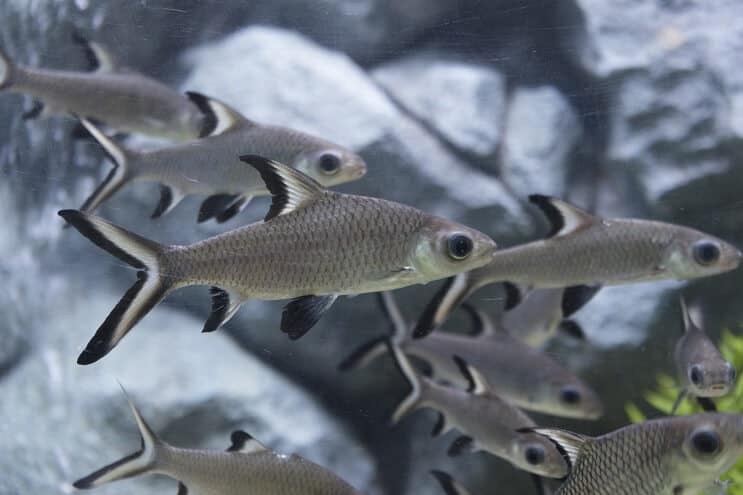
Bala sharks are peaceful fish that can be housed with other medium-to-large, peaceful fish. Don’t house them with aggressive or carnivorous fish like neon tetras.
Don’t add non-fish species like shrimps and crabs to a bala shark tank, because they are known to eat crustaceans.
Great tank mates for bala sharks include:
- Other bala sharks — bala sharks are shoaling fish that should be housed in groups of at least five
- Gouramis
- Corydoras
- Rasboras
- Rainbowfish
Diet and Feeding
In the wild, the bala shark’s diet consists of insects, small crustaceans, plant matter, algae, and larvae. Provide a similarly varied diet in captivity with a combination of live and dried foods.
High-quality dried food, like flakes and pellets, should make up the bulk of the bala shark’s diet. Look for nutritious foods that provide the vitamins, minerals, and proteins needed for these fish to grow to their full potential.
Diversify feeding by adding live, high-protein foods like bloodworms and shrimp to the tank, and regularly feed the fish plankton, diced fruits, greens, and vegetables to fortify the fish’s health.
Bala sharks should be fed up to three times per day. To avoid overfeeding, feed the fish an amount it can eat within about two minutes. No additional supplements are required as long as the fish has a balanced, diverse diet.
Breeding
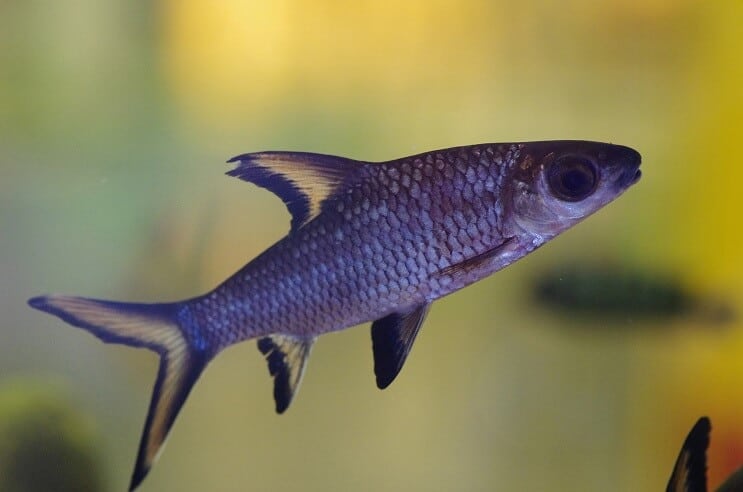
Breeding bala sharks is moderately difficult and best attempted by aquarists with fish-breeding experience. Bala sharks become sexually mature at around six months old, or when the fish have grown to four inches long.
To breed bala sharks, follow these steps:
- Place a group of five bala sharks in a separate 65-gallon breeding tank with a temperature of 77°F and a strong filter. Keep the bottom of the tank clear or add a breeding net to catch the eggs. Sexing the fish is difficult, and attempting breeding with a large group of fish increases the likelihood that there are males and females in the group.
- Initiate spawning by gradually increasing the water temperature to 82°F over the time span of a week. You should notice the females becoming rounder than normal, indicating the development of eggs.
- Interested males and females will spawn early in the morning, lasting for a couple of hours.
- After the female has laid eggs along the bottom of the tank, the male will fertilize the eggs with milt.
- Remove all fish from the tank, including the parents, to prevent the adults from eating the fry. Replace the filter with an internal sponge filter that won’t suck up the fry.
- Perform a 50% water change and add antibacterial solutions to the water. Within 24 hours, larvae should appear.
- The fry should hatch within three days. Feed the fry ciliates, then switch to nauplii of artemia or cyclops once the fry are four days old.
- Keep the fry in a separate tank until the fish reach six months old or four inches long.
Should You Get a Bala Shark for Your Aquarium?
Bala sharks are unique-looking fish that provide plenty of entertainment in a home aquarium.
You should get a bala shark if you have plenty of space for at least five of these active shoaling fish. Don’t get a bala shark if your tank is small or contains large predatory fish.
Despite needing a larger tank than most aquarium fish, bala sharks are peaceful and beautiful to look at, making them a fantastic choice for people who have enough tank space to house the species.

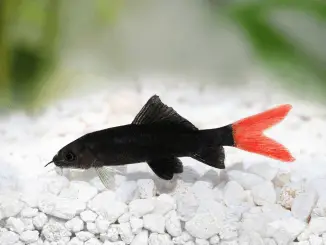
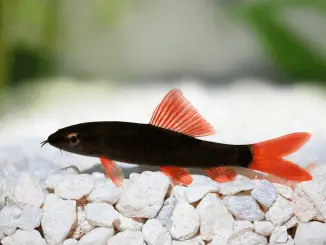
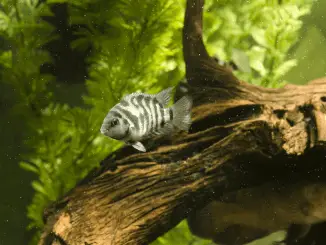
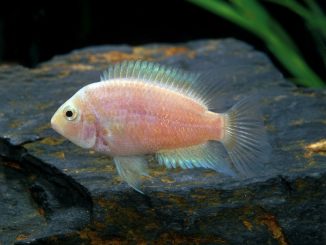
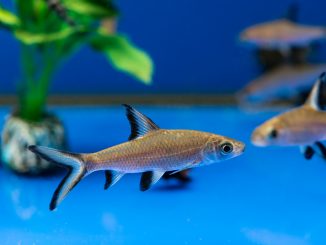
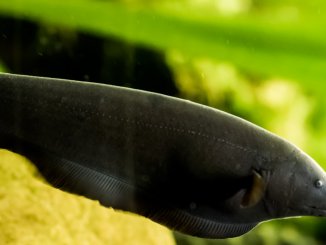
Hi I have a Bala shark that’s around 12 inches I started of with 4 but I gave away 2 of them after about 3 months as they were getting picked on and eventually another so I’m only left with the one but a friend has asked if I can re home his mollies in my tank I’m not sure with the Bala and a fully grown pleco any advice please?
Hi Ben, I personally wouldn’t risk it. The mollies may become food for the Bala! Thanks, Robert
I have 3 Bala in my tank together with 5 moderate size Angelfish, and 3 Gourami. And they are happy together :)
Just both 4 of them two days back. Now it looks like 2 of them have paired up. They are sticking together and kinda slapping their fin with each other. And one from these pair chase other two and when other fish comes near them it chase them too. I mostly have gold fish. So do I need to remove other two of them or completely take them out?
I have a 5ft tank with a mixture of gourami (honey pearl and blue dwarf). I also have some platys. Can I get a Bala shark to go in with these.
Hi William, I wouldn’t advise adding Bala Sharks to an existing tank. Ideally, you’d to it the other way around. Let the Bala Shark settle in and then add the Gouramis. If you want to keep Gouramis with a Bala Shark, choose larger species too. Thanks, Robert
Hi, thank you for som great reading, but im wondering if i could keep an elephant nose fish, a black ghost knife fish and a bala shark together in a 530 liters tank?
its not setup yet, im just researcing some cool fish :) and since black ghost is my favorit fish i will be getting one of those:)
i have a 120 liters tank running now with some guppies, kribensis chiklids, flying fox and some snails and shripms, im well aware they wont last long with a bala shark :) hehe
im no expert but i have kept severel kinds of fish over time :)
best regards Merete
Hi Merete, they would probably be OK for the first year or so, but will need a large tank as they grow. Robert
Would a Bala Shark be okay with platies and tetras in the same tank? (50 gallon tank)
Hi I have a Bala shark and i was thinking of adding a couple of tetras and platies in in the same tank and wondering if they would get along?
Hi, I keep Guppies with my Bala Sharks. They tend not to eat many of the fry, but if you are concerned, make sure you have a lot of plants, both at the surface and the bottom for fry to hide in until they are larger. I’ve also kept tetras without issue, however most tetras need to shoal, so make sure your tank has enough room for a large group of tetras plus growing Bala Sharks.
I have 2 balas and 3 Corey cats what kind of fruit and vegetables can I feed them and what plant’s can I put in there tank
I have a massive bala sharj i keep her in a 3ft tank she is housed with baby cichlids bristlenose plecs & male & female kribs she gets on great with them & leaves the babies alone i change water every 2 weeks & clean internal filter every week i had 4 to start with but 3 died but had her years learnt well & i have never done ph tests theres rocks boat & plastic plants along the botton plus i have 2 air supplies running & shes very happy but does not like ne in her tank as she splashes ne loads when it comes to tank clean but i must say i love her lol
I love reading the ads my bala shark is in a 3 foot tank also in there are african cichlid fry 2 kribs male female & 2 female * 1 male bristle nose plecs that breed so have pleco fry aswell * it works well
We have a 15 gallon with 2 Bala’s
One is s little more playful that the other. So far they are doing great with our 2 gouramis, 2 glo sharks, 4 guppies. I enjoyed the information about our daughters new pets.
I have a beautiful Bala shark in my 35 gallon tank. I had no idea that he would get this big. He is about 4 to 5 inches. I feel bad for him because he needs more room to swim. Does anyon know who would take him for me and give him more room to enjoy?
I just got a Bala shark wrongly labeled as a black fin shark in a tiny tank with a sucker fish. I’m currently looking for a MUCH bigger tank cause I don’t like how small the one it came in is, I’m very open to more tips as I want to make sure this guy gets the best.
Hi! One more comment/question would a Bala shark be okay living with an Oscar fish? And two upside down swimming cat fish?